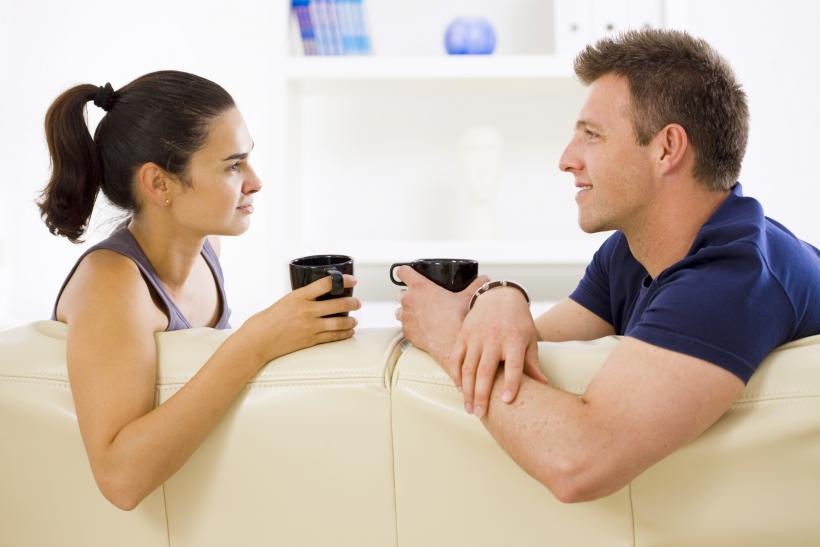
I’m trying to meet my husband where he is. To speak my husband's love language and, in the process, allow him to help me rediscover one of mine.
Any couple who has been married for longer than five minutes will tell you that communication is one of the tricks to having a happy, healthy relationship. But the nuances of how to successfully communicate with your spouse are often more elusive. We can “speak” different languages and thrive on opposing forms of intimacy — which can result in couples talking circles around one another or missing the mark completely.
I’ve experienced this personally with my husband of nine years. He refuses to take one of those online quizzes to identify his “love language,” but it doesn’t matter; even without the quiz results, I know that his language is Physical Touch.
I know because it’s the one I struggle most to speak.
According to “love language” creator and marriage expert Dr. Gary Chapman, the language of Physical Touch is about much more than just marital intimacy. (Otherwise, I’m pretty sure 99.9% of husbands would claim it as their love language, no quiz required.) Instead, this language is about hugs and kisses, hand-holding, and comforting pats on the back. It’s about reassuring your partner through simple touch and physical affection that you’re there for them.
For a type A, perfectionist wife and mother like myself, being present and available is something I have a hard time consistently doing for my husband. I run on a routine-oriented schedule of efficiency and productivity. There are three kids to dress, feed, chauffeur, care for, and attend to every day. There is a house to be cleaned, laundry to be washed, errands to be run. I have freelance deadlines to meet, and homeschool lesson plans to implement.
I am busy, busy, busy. I’m so busy that I can’t even keep track of all the things I don’t have time for anymore.
But I’m fighting it. I’m trying to meet my husband where he is. To put down the dishes and hug him. To speak his language and, in the process, allow him to help me rediscover one of mine.
And there, in the middle of it all, is my long-enduring husband. Rubbing my back while I wash dishes. Reaching across the console for my hand in the car. Waiting for me to stand still long enough to pull me into a hug. Searching for a certain kind of affirmation and connection that I’m often unaware he needs, blinded by my busyness.
When I took the online “love languages” quiz myself, Physical Touch was at the very bottom of my profile. (Literally. It scored a “1.”) Words of Affirmation was my highest score, which makes sense: as a writer, I put a lot of stock in words. I like to be told in no uncertain terms how someone feels about me or my contributions to our relationship.
But that lonely little number “1” at the bottom of my profile bothered me.
I never considered myself to be unaffectionate — or at least I hadn’t always been that way.
I remember the years I spent long distance-dating my husband — holding his hand as we walked down the street, cuddling up on the couch to watch TV, counting down the days, hours, and minutes until I could be wrapped up in a good old-fashioned I-missed-you-so-much hug. I craved it then just as much as my husband does now.
So what happened? Life. It changed, and I changed along with it.
You Might Also Like: My Husband And I Don’t French Kiss Anymore
I used to be fluent in the language of Physical Touch before nine years of marriage, seven years of parenthood, and three young children sucked it out of me. Now that dialect feels inaccessible, foreign to my current lifestyle. Who has time for hugging? Like I said — I'm always busy.
So is my husband, though, and he still manages to speak this particular language. Sometimes, early in the morning, he approaches me as I’m unloading the dishwasher or pouring cereal into bowls or hauling laundry to the basement to ask if he can hug me. It isn’t even about him — he’s not asking for me to hug him. He wants to hug me. It’s as if he knows, better than I do, that I need one. It’s as if he remembers how I used to speak this language too, how I used to seek out a physical connection with him and find comfort in it.
I’ll admit that it feels like a hassle at first to be interrupted. Type A perfectionists don’t like to be diverted from their tasks and objectives. And it’s nearly always ill-timed: there are usually kids clamoring around us, in various stages of undress and hunger, asking for the things that small people typically ask for. My first impulse is to defer, telling him I’m too overwhelmed or that I don’t need a hug.
But I’m fighting it. I’m trying to meet my husband where he is. To put down the dishes and hug him. To speak his language and, in the process, allow him to help me rediscover one of mine.
It feels important — not just to our marriage, but to our family, our three sons, who I hope grow up seeing their parents hug and kiss and touch one another.
My kids are still too little to have defined languages they speak, but my middle son craves touch, too. He comes to find me while I’m working or folding clothes or cooking dinner and tells me he is going to hug me.
“I’ll just give you one hug, Mommy, okay?” he says.
For a split second, I feel it: the urge to say not right now, or just let me finish this, or thanks, but I don’t need one. Then I fight it. I put down the dishes or the laundry or the laptop. I say okay and let him hug me, his small arms circling my shoulders and his thick hair pressing against my cheek. I hold him tightly, letting him know I’m present and available.
It still feels foreign sometimes, to speak this lost language. But then my son steps back, his face a younger version of my husband’s, and I know I have to try to remember the words — for them and for me.








